Reproduction in mammals
Fertilisation in mammals occurs internally. After fertilisation the fertilised egg is laid or develops within the female body in a special structure, the uterus.
The egg laying mammals (MONOTREMES) Are said to be oviparous. An example of an oviparous mammal is the platypus.
In some mammals, the zygote does not develop fully within the uterus but completes development within a special structure called pouch as in the marsupials eg kangaroo.
In most mammals however, the zygote develops fully into a young mammal which resembles that adult.
The ability to give birth to young as in placental mammals is referred to as Viviparity. mammals whose zygotes develop within the uterus have mammary glands. The glands produce milk on which the young ones feed on until they are able to feed on the same food as adults. In these mammals, parental care is highly developed.
Reproduction in Human Beings
Structure of female reproduction system

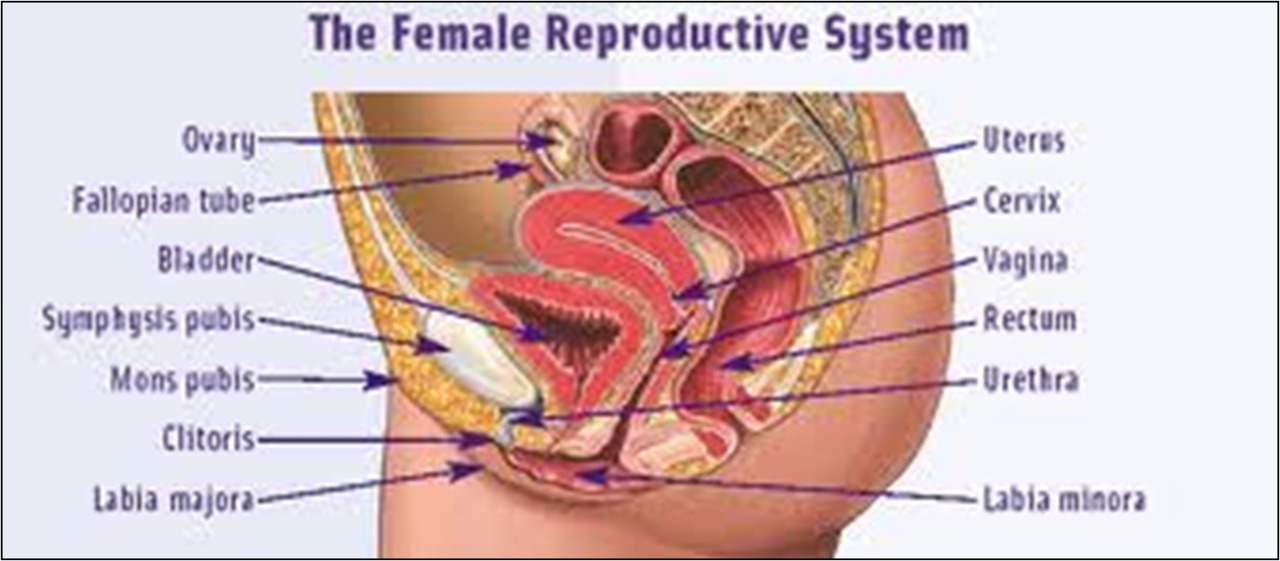
The female reproduction system consists of the following:
1. Ovaries
• Are two oval cream coloured structures found in lower abdomen below the kidneys.
• have several graafian follicles that develop and burst open to release/produce mature ova
• secretes sex hormones)oestrogen) which initiate/control development of secondary sexual characteristics
• produce hormones oestrogen and progesterone which prepare the uterus for implantation and subsequent nourishment of the embryo.
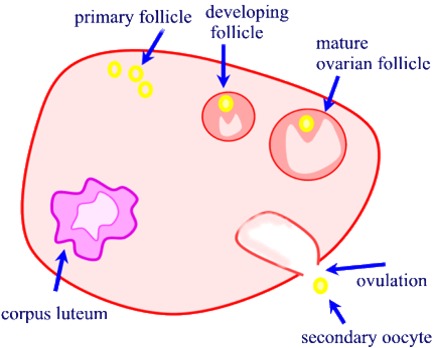
Adaptations of the ovum to its function
• nucleus contains genetic material
• ventelline membrane encloses plasma membrane which encloses yolky cytoplasm
• yolky cytoplasm provides nourishment
• jelly coat protects ovum against dehydration
2. Oviducts(fallopian tube)
• Are tubes which conduct the ova produced by the ovaries to the uterus.
• Fertilisation occurs in the upper part of the oviduct.
• are thin narrow and tubular to increase flowing speed of semen containing sperms
• are funnel shaped on the end next to ovary which enables them to receive the ovum
• their lining contains cilia which propel the ovum towards the uterus
• has peristaltic muscles that enable movement of zygote/ovum to the uterus for implantation
• is fairly long to increase surface area for fertilization
3. Uterus
• The uterus is a hollow muscular organ found in the lower abdomen.
• The embryo develops inside the uterus.
• The inner lining endometrium supplies nutrients to embryo.
• The embryo is implanted into the inner uterine wall- the endometrium which nourishes the embryo.
• The thick muscles of the uterus assist in parturition.
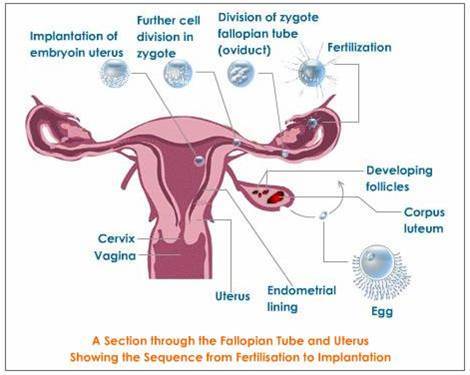
4. Cervix
• Has a ring of muscles that separates the uterus from the vagina.
• It forms the opening to the uterus
• has valves that close the lower end of the uterus to ensure continued pregnancy during gestation period
is capable of dilating
• has narrow entrance/neck-like entrance to uterus that enables quick swimming of sperms to uterus
• has suction mechanism that draws up/pulls sperms into uterus
• has a “W” shape that fits well with the glands of the penis to ensure sperms are deposited at the right point
5. Vagina
• Is a tube that opens to the outside and it acts as the copulatory and birth canal through the vulva.
• it is elastic and muscular to enable good accommodation or penetration of the penis thus proper deposition of sperms and for easy parturition
• allows menstrual flow
• has sensitive labial walls which secrete/produce lubricating substances that ensure/enable/facilitate good coition
• capable of considerable enlargement, due to elastic muscles, to accommodate baby during parturition.
6. Clitoris
• has sensitive cells for orgasm
Structure of male reproductive system
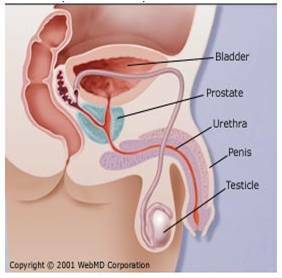
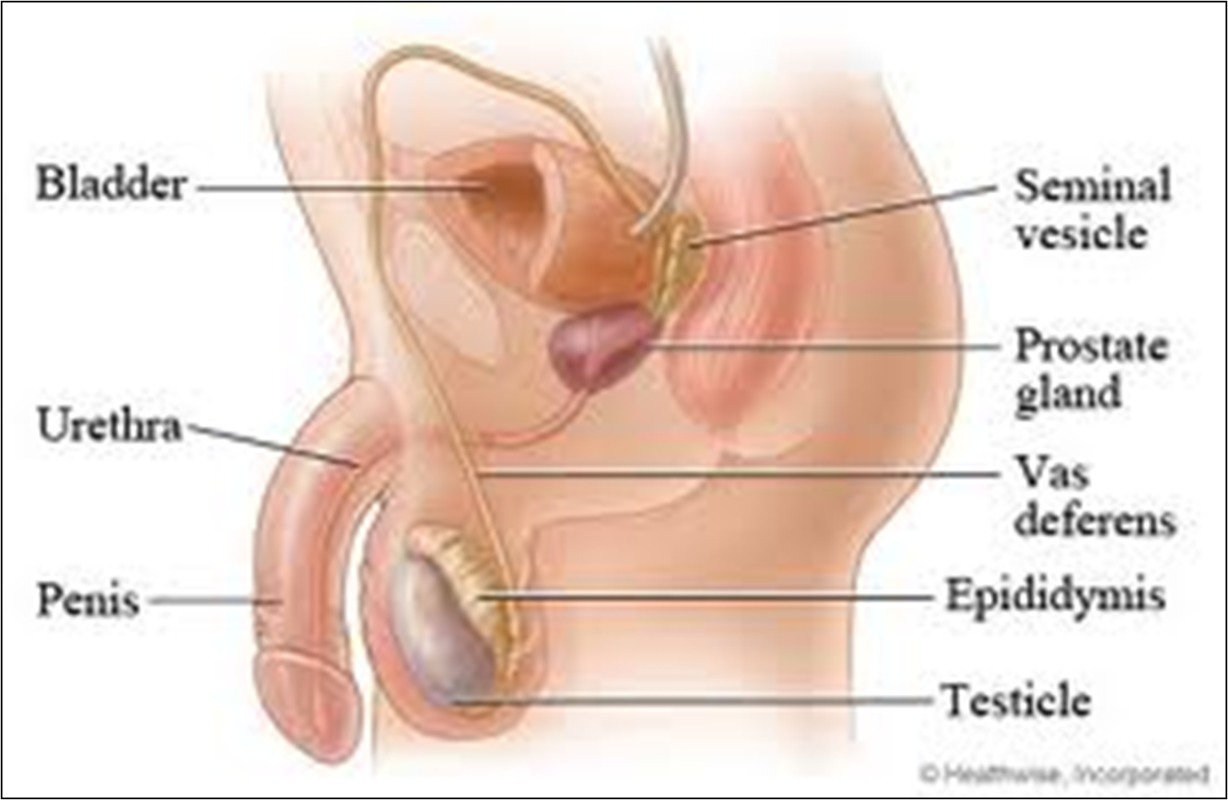
The male reproductive system consists of the following:
1. Testis:
• Each testis is a mass of numerous coiled tubes called semniferous tubules.
• Each is enclosed within a scrotal sac that suspends them between the thighs.
• This ensures that sperms are maintained at a temperature lower than that of the main body.
2. Seminiferous tubules
• The lining of seminiferous tubules consists of actively dividing cells which give rise to sperms.
• Between the seminiferous tubules are interstitial cells which produce the male hormones called androgens e.g. testosterone.
• The seminiferous tubules unite to form the epididymis, which is a coiled tube where sperms are stored temporarily.
• Vas deferens (sperm duct) is the tube through which sperms are carried from testis to urethra.
• Seminal vesicle produces an alkaline secretion which nourishes the spermatozoa.
3. Prostate gland
• Produces an alkaline secretion to neutralise vaginal fluids.
Cowpers' gland
• Secretes an alkaline fluid.
• All these fluids together with spermatozoa form semen.
4. Urethra
• Is a long tube through which the semen is conducted during copulation.
• It also removes urine from the bladder.
5. Penis
• Is an intro-mittent organ which is inserted into the vagina during copulation .
• is highly vascularised/spongy
• has a sensitive glands
• becomes erect to allow entry into the vagina
6. Scrotum
• contains the testes outside the body on whose walls the process of spermatogenesis takes place
• the process is favored by lower temperature
• it contains sertoli cells which nourish sperms until they are mature
7. Epididymis
• long and coiled for the purpose of sperm storage
8. Vas deferens
• muscular
• upon contraction pushes sperms out and allows ejaculation
Gametes
• produced in large numbers to increase chances of fertilization
• the sperms have a tail for swimming/large number of mitochondria to provide energy/allow swimming to reach the egg
9. Accessory glands
• are seminal vesicle, Cowper’s gland and prostate gland
• they produce seminal fluid to provide a medium/ nutrients for sperms to swim
Adaptation of the sperm to its function
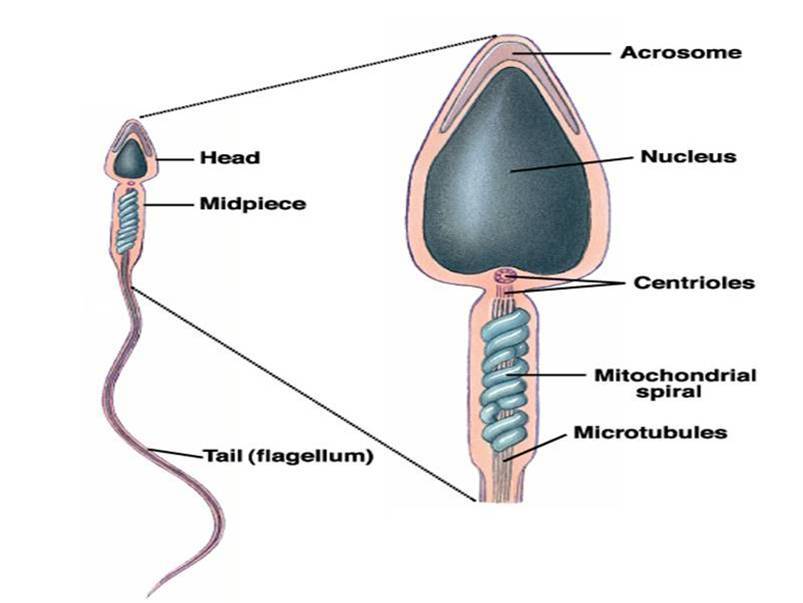
• Acrosomes contain enzymes to digest egg membrane
• Nucleus contains genetic material
• Mitochondria produce energy to move the tail back and forth
• The lashing movement of the tail enables the sperm to move/propulsion in fluid medium towards the egg
• It is streamlined for faster/easier movement/swimming to meet the egg.
Differences between sperm and ovum
The egg laying mammals (MONOTREMES) Are said to be oviparous. An example of an oviparous mammal is the platypus.
In some mammals, the zygote does not develop fully within the uterus but completes development within a special structure called pouch as in the marsupials eg kangaroo.
In most mammals however, the zygote develops fully into a young mammal which resembles that adult.
The ability to give birth to young as in placental mammals is referred to as Viviparity. mammals whose zygotes develop within the uterus have mammary glands. The glands produce milk on which the young ones feed on until they are able to feed on the same food as adults. In these mammals, parental care is highly developed.
Reproduction in Human Beings
Structure of female reproduction system


The female reproduction system consists of the following:
1. Ovaries
• Are two oval cream coloured structures found in lower abdomen below the kidneys.
• have several graafian follicles that develop and burst open to release/produce mature ova
• secretes sex hormones)oestrogen) which initiate/control development of secondary sexual characteristics
• produce hormones oestrogen and progesterone which prepare the uterus for implantation and subsequent nourishment of the embryo.

Adaptations of the ovum to its function
• nucleus contains genetic material
• ventelline membrane encloses plasma membrane which encloses yolky cytoplasm
• yolky cytoplasm provides nourishment
• jelly coat protects ovum against dehydration
2. Oviducts(fallopian tube)
• Are tubes which conduct the ova produced by the ovaries to the uterus.
• Fertilisation occurs in the upper part of the oviduct.
• are thin narrow and tubular to increase flowing speed of semen containing sperms
• are funnel shaped on the end next to ovary which enables them to receive the ovum
• their lining contains cilia which propel the ovum towards the uterus
• has peristaltic muscles that enable movement of zygote/ovum to the uterus for implantation
• is fairly long to increase surface area for fertilization
3. Uterus
• The uterus is a hollow muscular organ found in the lower abdomen.
• The embryo develops inside the uterus.
• The inner lining endometrium supplies nutrients to embryo.
• The embryo is implanted into the inner uterine wall- the endometrium which nourishes the embryo.
• The thick muscles of the uterus assist in parturition.

4. Cervix
• Has a ring of muscles that separates the uterus from the vagina.
• It forms the opening to the uterus
• has valves that close the lower end of the uterus to ensure continued pregnancy during gestation period
is capable of dilating
• has narrow entrance/neck-like entrance to uterus that enables quick swimming of sperms to uterus
• has suction mechanism that draws up/pulls sperms into uterus
• has a “W” shape that fits well with the glands of the penis to ensure sperms are deposited at the right point
5. Vagina
• Is a tube that opens to the outside and it acts as the copulatory and birth canal through the vulva.
• it is elastic and muscular to enable good accommodation or penetration of the penis thus proper deposition of sperms and for easy parturition
• allows menstrual flow
• has sensitive labial walls which secrete/produce lubricating substances that ensure/enable/facilitate good coition
• capable of considerable enlargement, due to elastic muscles, to accommodate baby during parturition.
6. Clitoris
• has sensitive cells for orgasm
Structure of male reproductive system


The male reproductive system consists of the following:
1. Testis:
• Each testis is a mass of numerous coiled tubes called semniferous tubules.
• Each is enclosed within a scrotal sac that suspends them between the thighs.
• This ensures that sperms are maintained at a temperature lower than that of the main body.
2. Seminiferous tubules
• The lining of seminiferous tubules consists of actively dividing cells which give rise to sperms.
• Between the seminiferous tubules are interstitial cells which produce the male hormones called androgens e.g. testosterone.
• The seminiferous tubules unite to form the epididymis, which is a coiled tube where sperms are stored temporarily.
• Vas deferens (sperm duct) is the tube through which sperms are carried from testis to urethra.
• Seminal vesicle produces an alkaline secretion which nourishes the spermatozoa.
3. Prostate gland
• Produces an alkaline secretion to neutralise vaginal fluids.
Cowpers' gland
• Secretes an alkaline fluid.
• All these fluids together with spermatozoa form semen.
4. Urethra
• Is a long tube through which the semen is conducted during copulation.
• It also removes urine from the bladder.
5. Penis
• Is an intro-mittent organ which is inserted into the vagina during copulation .
• is highly vascularised/spongy
• has a sensitive glands
• becomes erect to allow entry into the vagina
6. Scrotum
• contains the testes outside the body on whose walls the process of spermatogenesis takes place
• the process is favored by lower temperature
• it contains sertoli cells which nourish sperms until they are mature
7. Epididymis
• long and coiled for the purpose of sperm storage
8. Vas deferens
• muscular
• upon contraction pushes sperms out and allows ejaculation
Gametes
• produced in large numbers to increase chances of fertilization
• the sperms have a tail for swimming/large number of mitochondria to provide energy/allow swimming to reach the egg
9. Accessory glands
• are seminal vesicle, Cowper’s gland and prostate gland
• they produce seminal fluid to provide a medium/ nutrients for sperms to swim
Adaptation of the sperm to its function

• Acrosomes contain enzymes to digest egg membrane
• Nucleus contains genetic material
• Mitochondria produce energy to move the tail back and forth
• The lashing movement of the tail enables the sperm to move/propulsion in fluid medium towards the egg
• It is streamlined for faster/easier movement/swimming to meet the egg.
Differences between sperm and ovum
| Sperm | Ovum |
| • long with a tail and head | • spherical |
| • small | • large |
| • locomotory | • stationary |
| • stores little food | • a lot of food stored in yolky cytoplasm |
| • has acrosome (tip with lytic enzymes) | • lacks acrosome |
| • nucleus prominent but cytoplasm negligible | • a lot of cytoplasm |